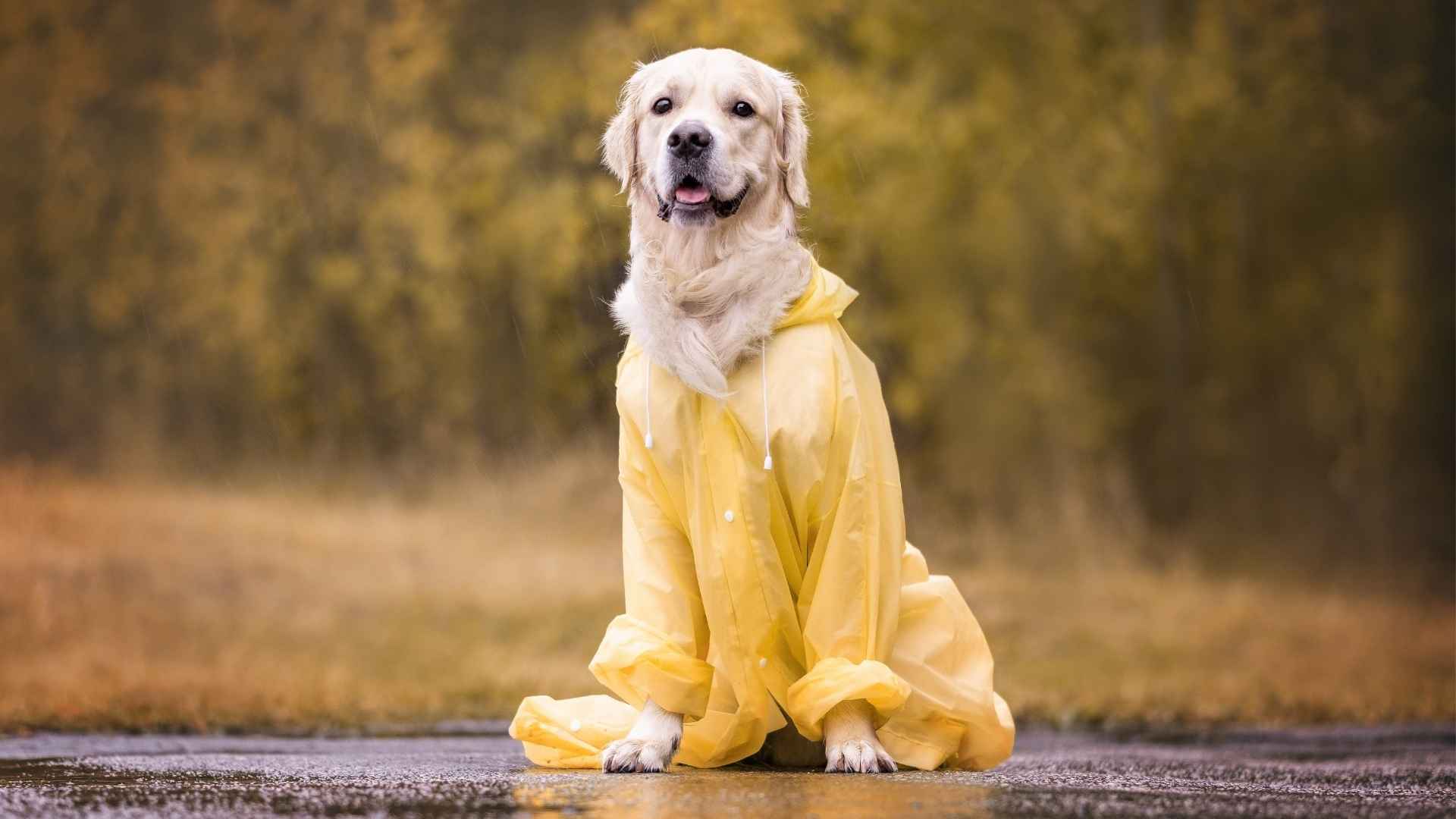Rainy days can dampen the spirits of even the most devoted dog lovers, but not all breeds shy away from a little drizzle. In fact, some dogs are perfectly built for the wet and muddy fun that comes with the rainy season. With thick, water-resistant coats, high energy levels, and a natural love for outdoor adventures, these breeds don’t just endure the rain—they thrive in it. Whether it’s splashing through puddles or trotting confidently through a storm, these dogs know how to make the most of a soggy day.
When choosing a dog to fit your lifestyle, weather adaptability plays a key role. For those living in regions with frequent rainfall, it’s essential to select a breed that won’t mind getting its paws wet. Rain-tolerant dogs tend to be physically robust, mentally agile, and emotionally adaptable—traits that make them excellent year-round companions, regardless of the forecast.
From spirited working breeds to easygoing companions, the best rainy season dog breeds combine resilience, enthusiasm, and charm. If your ideal day includes walks beneath overcast skies and muddy backyard play, these water-loving breeds might just be your perfect match. Let’s take a closer look at the dogs that don’t just survive the rain—they celebrate it.
Best Rainy Season Dog Breeds
1. Alaskan Malamute
The Alaskan Malamute, an ancient sled-pulling breed from Alaska, is renowned for its power, endurance, and spirited nature. Originally developed by the Mahlemut Inuit tribe, this majestic dog was used for hauling heavy freight across frozen terrain.
As a member of the Working Group, Malamutes typically weigh between 75 to 85 pounds and stand around 23 to 25 inches tall. Their dense double coat, bushy tail, and erect ears contribute to their wolf-like appearance, while their almond-shaped brown eyes reflect a gentle, affectionate personality.
Although best suited to colder climates, their thick, weatherproof fur also helps them tolerate rainy weather with ease, making them a resilient companion during wet seasons. According to the AKC, the Alaskan Malamute is known for being affectionate, loyal, and playful while maintaining a dignified demeanor.
Care Needs
The Malamute’s heavy coat requires frequent brushing, especially during the rainy season, to prevent matting and skin issues. These high-energy dogs need regular physical and mental stimulation—long walks, hikes, and puzzle games are ideal.
Because of their size and strength, early socialization and firm, consistent training are essential. A spacious environment where they can roam and stay cool is preferred. Despite their love for outdoor activity, Malamutes form deep bonds with their families and thrive best when they’re included in household life.
Fun Fact: Alaskan Malamutes can pull weights of up to 3,000 pounds when trained!
2. Border Collie
The Border Collie, celebrated as one of the most intelligent and agile dog breeds, hails from the border regions between England and Scotland. Originally bred for herding sheep, this medium-sized herder stands between 18 and 22 inches tall and typically weighs 30 to 45 pounds.
Known for their intense focus, athleticism, and unmatched trainability, Border Collies are members of the Herding Group and thrive on having tasks to complete.
According to Britannica, the Border Collie is renowned for its exceptional intelligence. Their weather-resistant double coat comes in both rough and smooth varieties, and in a range of colors and markings.
Care Needs
Border Collies need a great deal of physical and mental stimulation, making them ideal companions for rainy-day outdoor adventures. While their dense coat offers protection from drizzle and damp conditions, regular grooming is necessary to manage shedding.
Mental enrichment, like puzzle games and agility exercises, is essential, especially during extended indoor stays. They’re known to enjoy water sports and even swimming, though individual preferences may vary. Introduce them to wet environments gradually and with positive reinforcement for the best results.
Fact: Border Collies are often used in water-based competitions such as dock diving, showcasing their surprising affinity for aquatic play.
3. Newfoundland
The Newfoundland, affectionately known as the “Newfie,” is a gentle giant originally bred to assist fishermen in icy Canadian waters. Belonging to the Working Group, these dogs are as powerful as they are compassionate.
Males typically stand 28 inches tall and weigh between 130–150 pounds, while females range from 26 inches and weigh 100–120 pounds. PetMD states that Newfoundlands, often called Newfies, are not just among the largest dog breeds, but also among the most gentle and friendly in temperament.
Their broad heads, soulful eyes, and thick, water-resistant double coats come in shades like black, brown, gray, or the iconic Landseer black-and-white. Despite their size, Newfoundlands are calm, patient, and famously good with children, earning the nickname “nanny dog.”
Care Needs
Due to their thick, coarse coat and considerable size, Newfoundlands require regular grooming—expect consistent brushing to manage shedding and coat maintenance. Their facial structure also means they drool frequently, so daily cleanup is necessary.
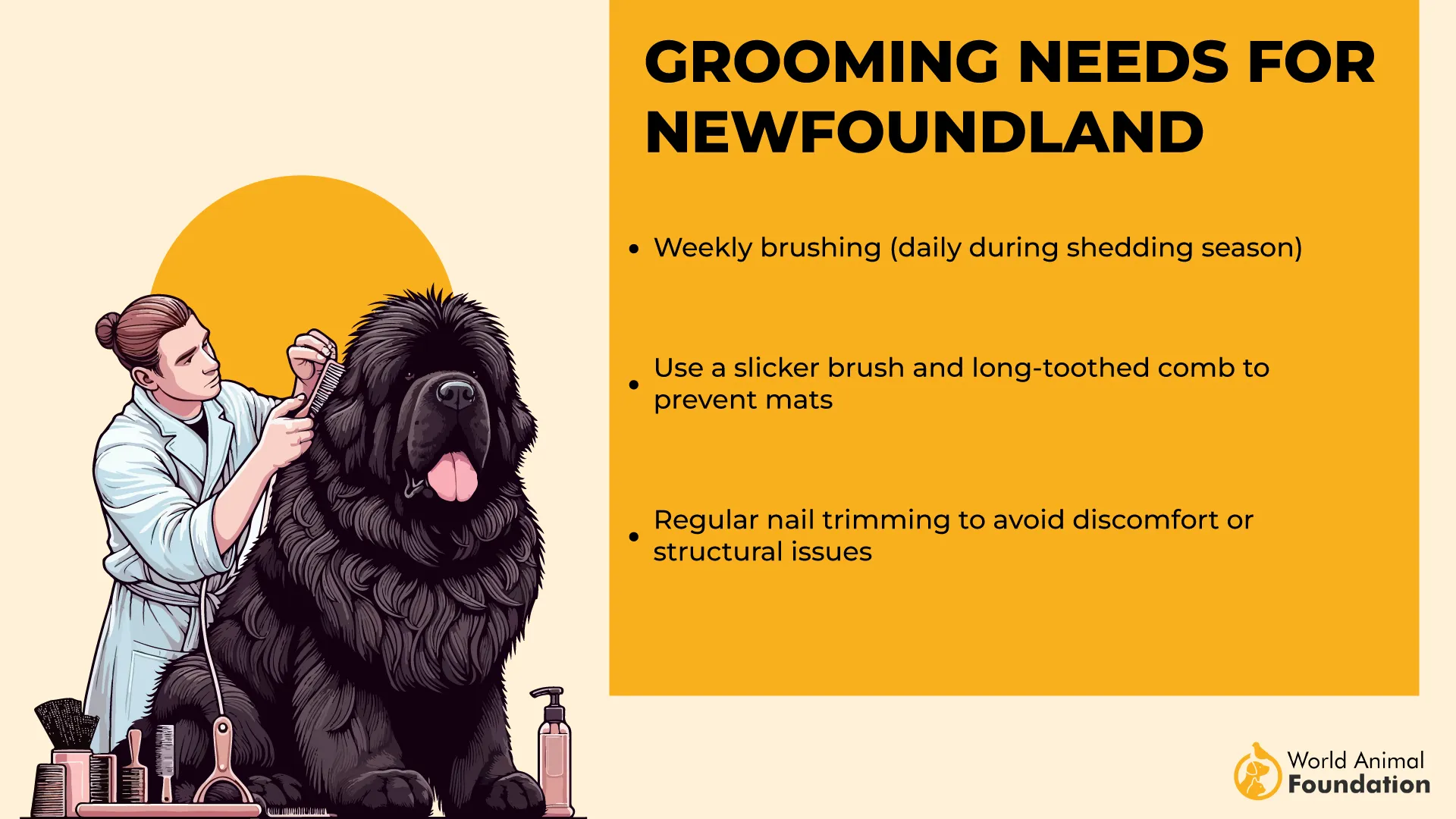
Exercise should be steady but not excessive; these dogs thrive near water and enjoy swimming. Owners must ensure they have enough space, especially during wet seasons, as these dogs love to stay outdoors. With proper care, their loyal and affectionate temperament makes them beloved rainy-day companions.
Fact: Newfoundlands are so strong in water that they’ve historically been used for lifesaving water rescues.
4. Golden Retriever
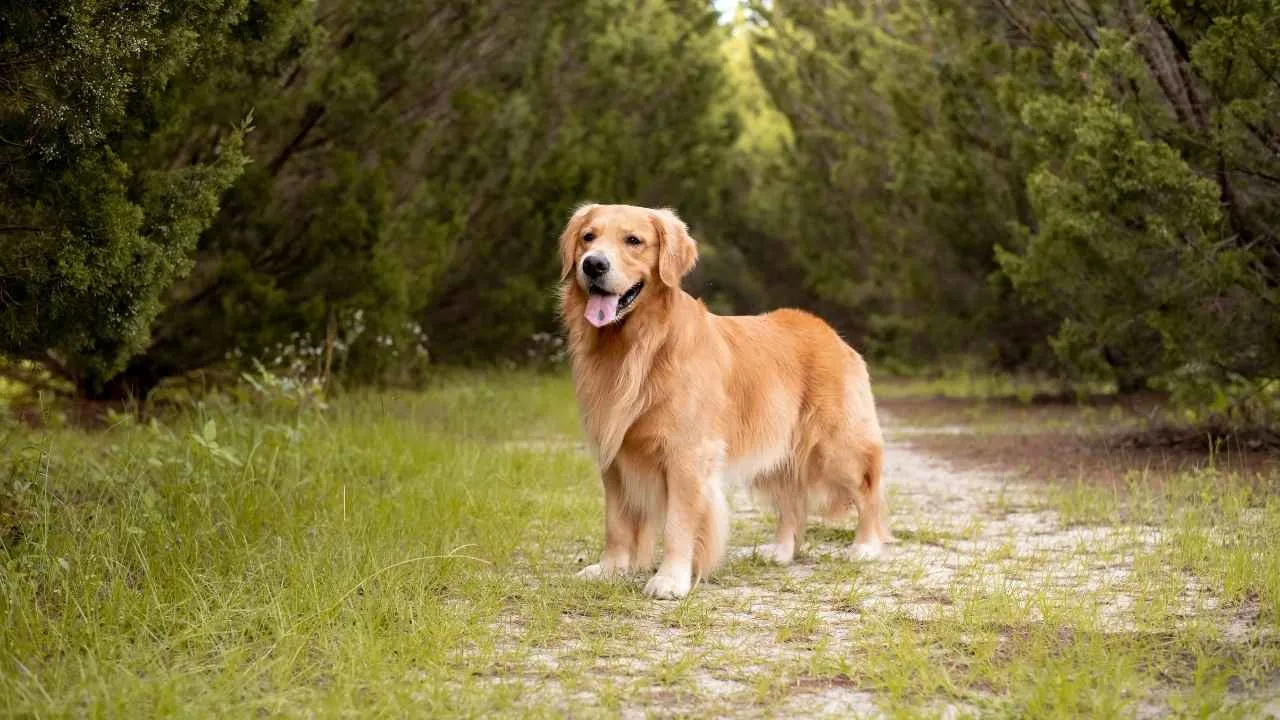
Golden Retrievers are one of the most beloved breeds in the world, cherished for their friendly nature, intelligence, and stunning golden coats. Originating in Scotland, these medium-sized gundogs were initially developed in the 19th century for retrieving game from water and rugged terrain.
With a height of 21 to 24 inches and weighing between 55 to 75 pounds, Goldens boast a sturdy, athletic build that allows them to excel in outdoor environments. Their dense, water-repellent double coats make them especially well-suited for rainy climates, as they can stay dry and comfortable even during heavy showers.
Known for their good-natured temperament and eagerness to please, Golden Retrievers make fantastic companions for families and thrive in homes where they can stay active and engaged year-round.
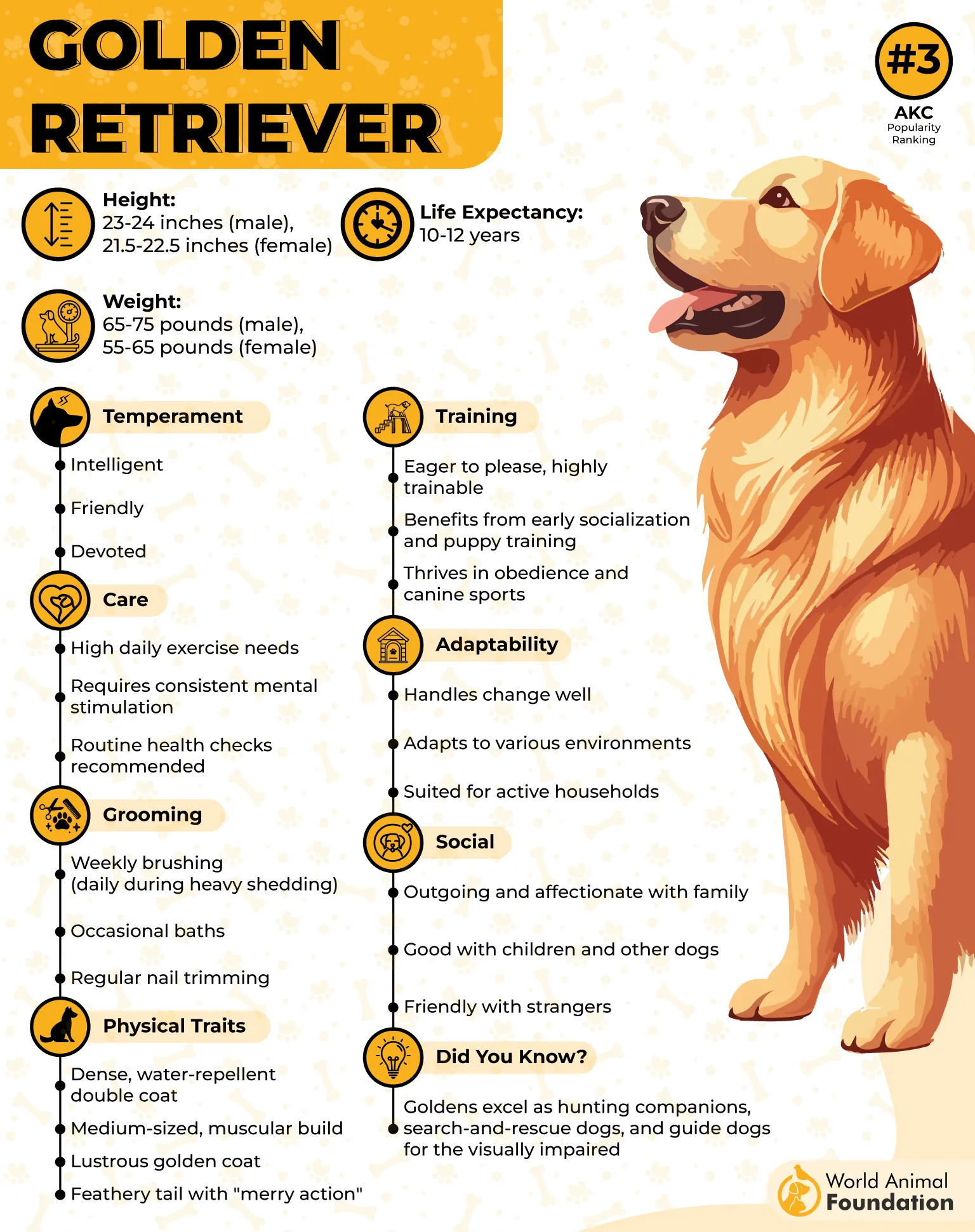
Care Needs
Golden Retrievers require regular grooming to manage their thick, shedding coats, especially after rainy play sessions that may cause tangling or matting. Weekly brushing and occasional baths will help maintain their coat’s health.
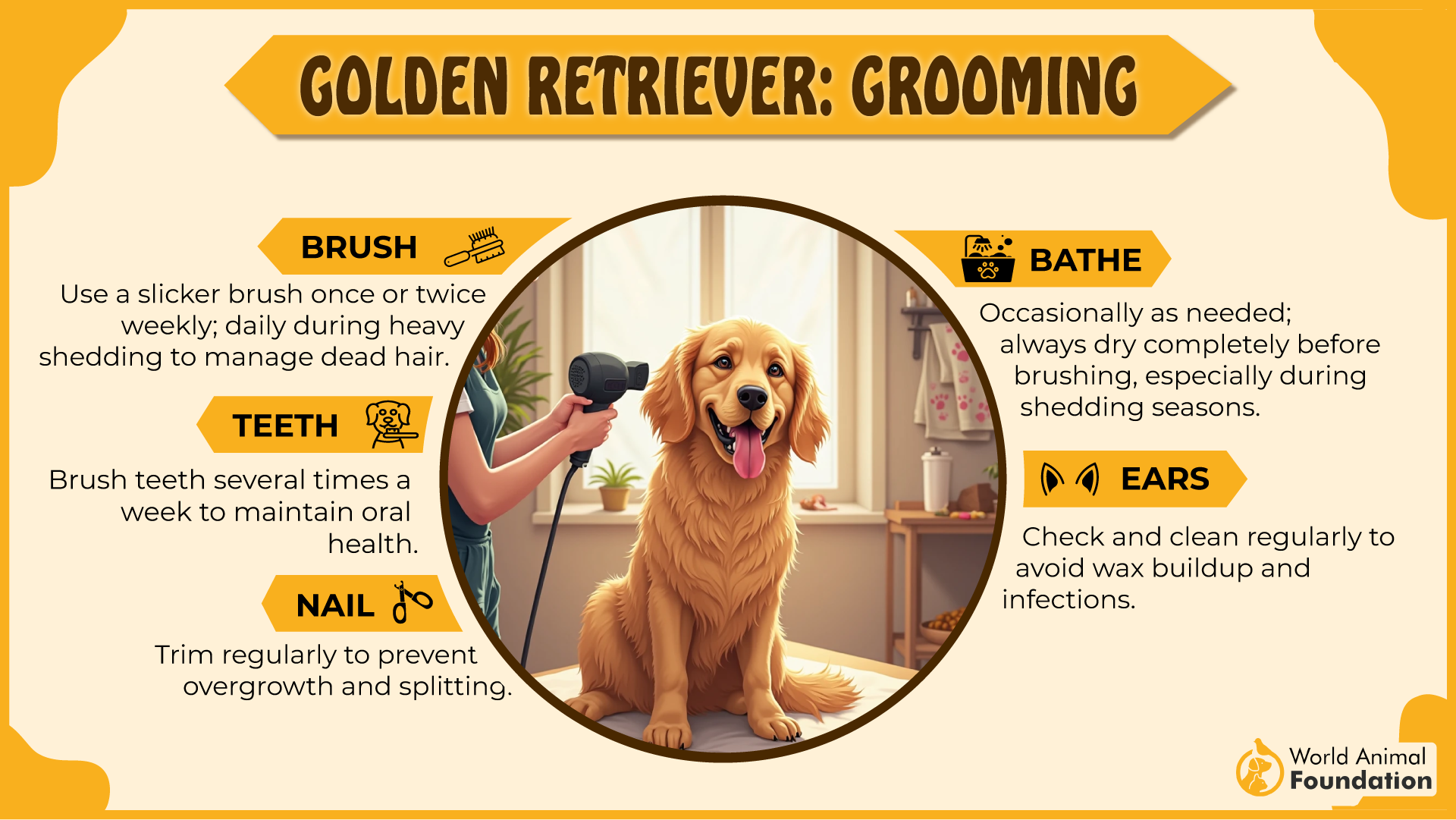
These companion dogs are moderately active and benefit from daily walks, swimming, and games of fetch. Their love for water means puddles and rain are more invitation than a deterrent. Fun fact: Goldens retain a joyful, puppy-like demeanor well into adulthood.
5. Samoyed
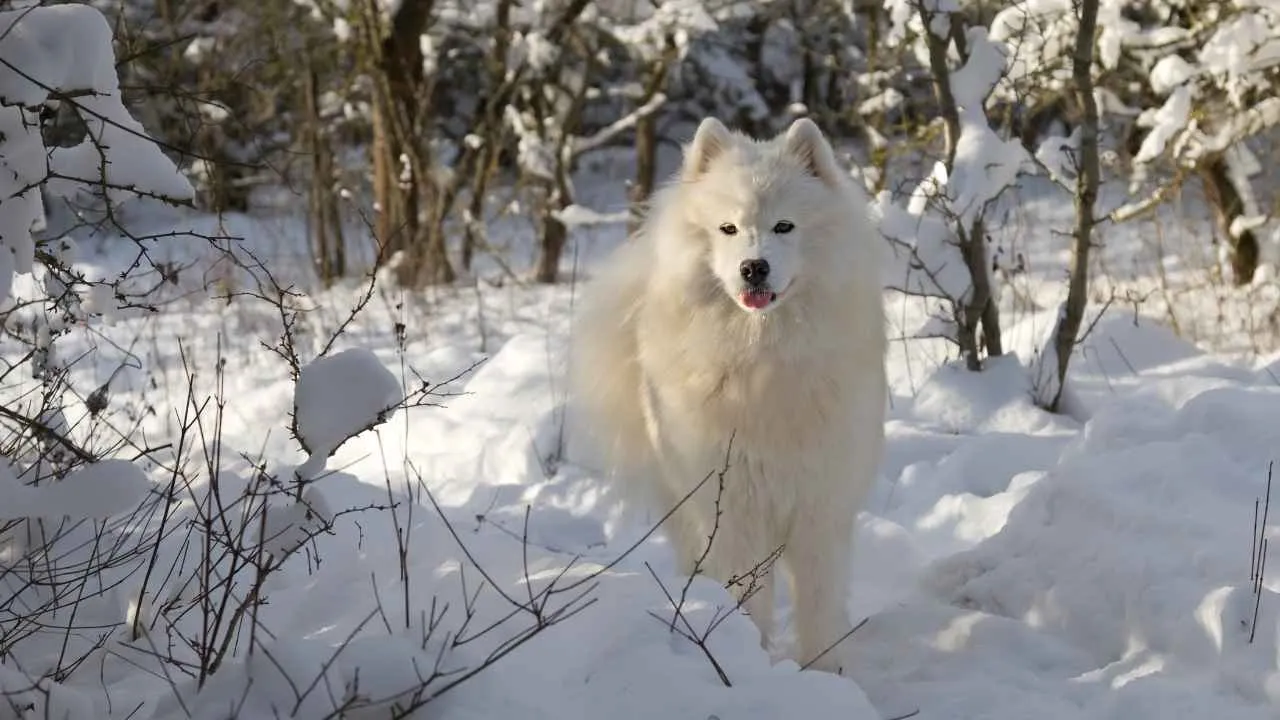
The Samoyed, often nicknamed the “smiling sled dog,” is a striking breed recognized for its brilliant white coat and cheerful expression. Originating from Siberia, this ancient working dog was bred by the Samoyedic people to herd reindeer, pull sleds, and serve as loyal companions.
Males typically stand around 21 to 23.5 inches tall, while females are slightly smaller, and their weight ranges from 35 to 65 pounds.
Their dense, double-layered coat offers superb insulation, making them resilient in cold and wet climates, perfect for active families living in regions with heavy rain or snow. Samoyeds belong to the Working Group and generally enjoy a lifespan of 12 to 14 years.
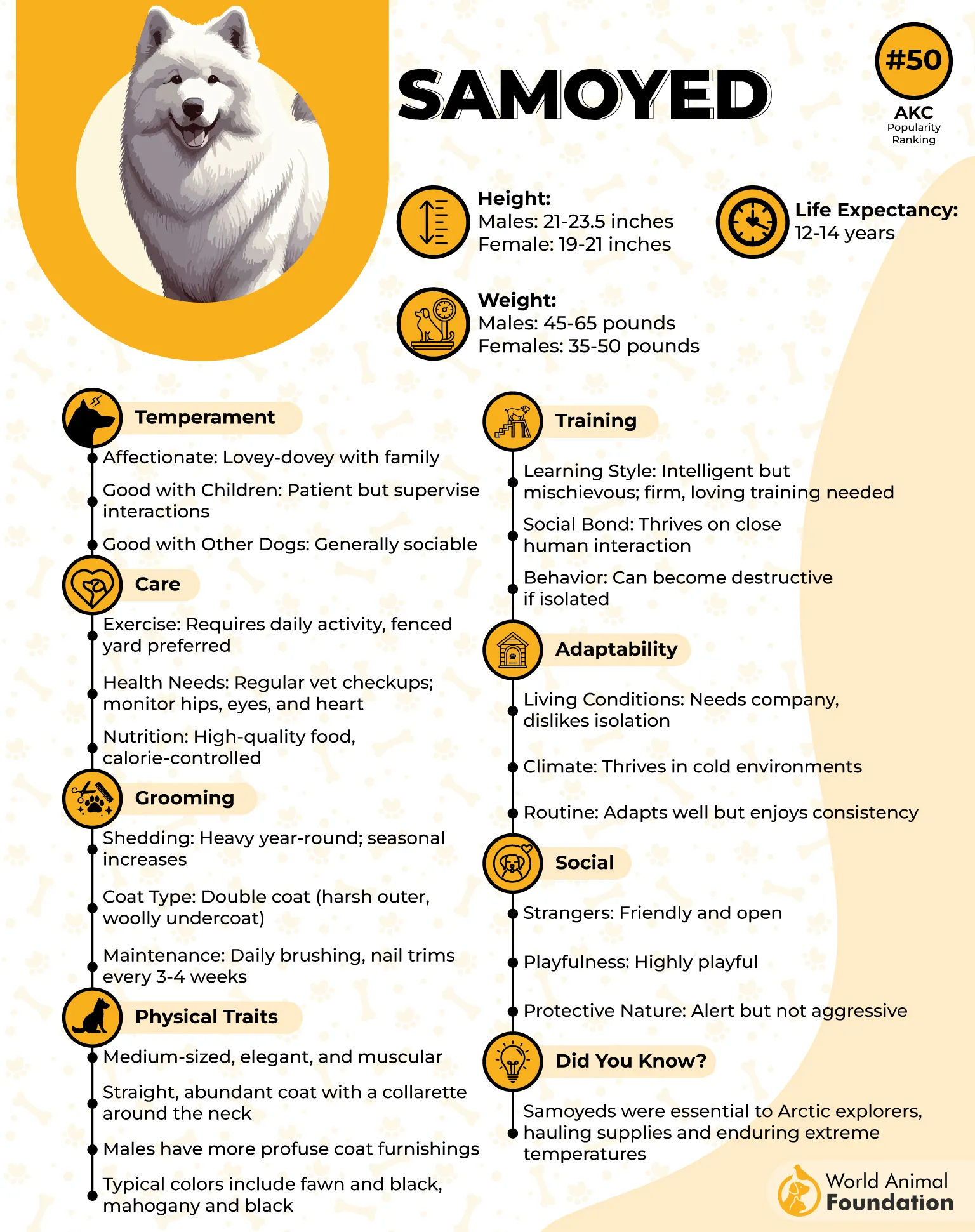
Care Needs
This ancient breed requires daily mental and physical activity to stay happy and healthy. They thrive on long walks, snowy romps, or even rainy-day adventures. Their thick coats demand consistent grooming to avoid matting and reduce shedding.
Although they prefer cooler environments with ample hydration and shade, they can tolerate warmer, damp weather. They are social dogs and dislike isolation, which can lead to destructive behavior if left alone for too long.
Fun Fact: The Samoyed’s signature “smile” isn’t just adorable—it prevents drool from freezing in cold climates.
6. Portuguese Water Dog
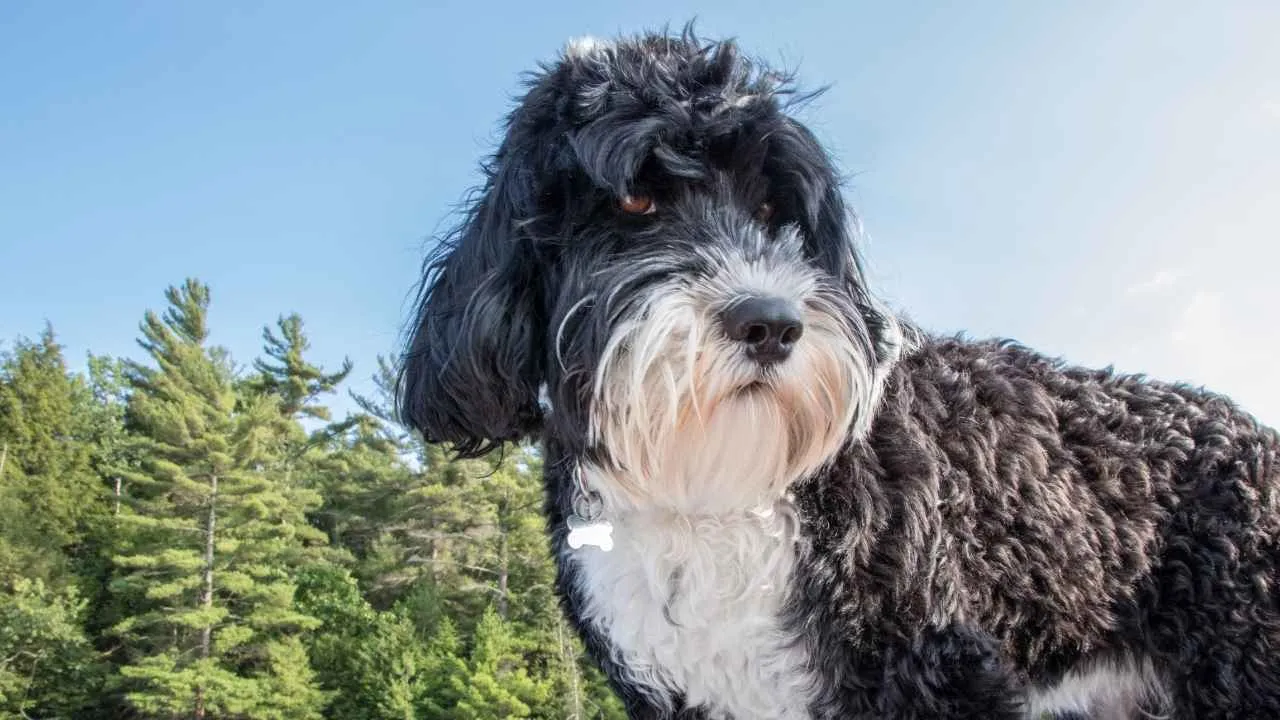
Bred as a loyal companion to Portuguese fishermen, the Portuguese Water Dog—often referred to as the “Portie”—has a rich history of working in aquatic environments. This medium-sized breed typically stands between 17 to 23 inches tall and weighs 35 to 60 pounds.
Their strong, athletic frame, paired with a dense, curly or wavy coat, enables them to thrive in wet and rainy conditions. They belong to the Working Group and are known for their boundless energy, intelligence, and spirited nature.
Their waterproof coat is both functional and endearing, making them an excellent fit for rainy day adventures. Portuguese Water Dogs enjoy mental stimulation, physical exercise, and social interaction, making them ideal for families with an active lifestyle.
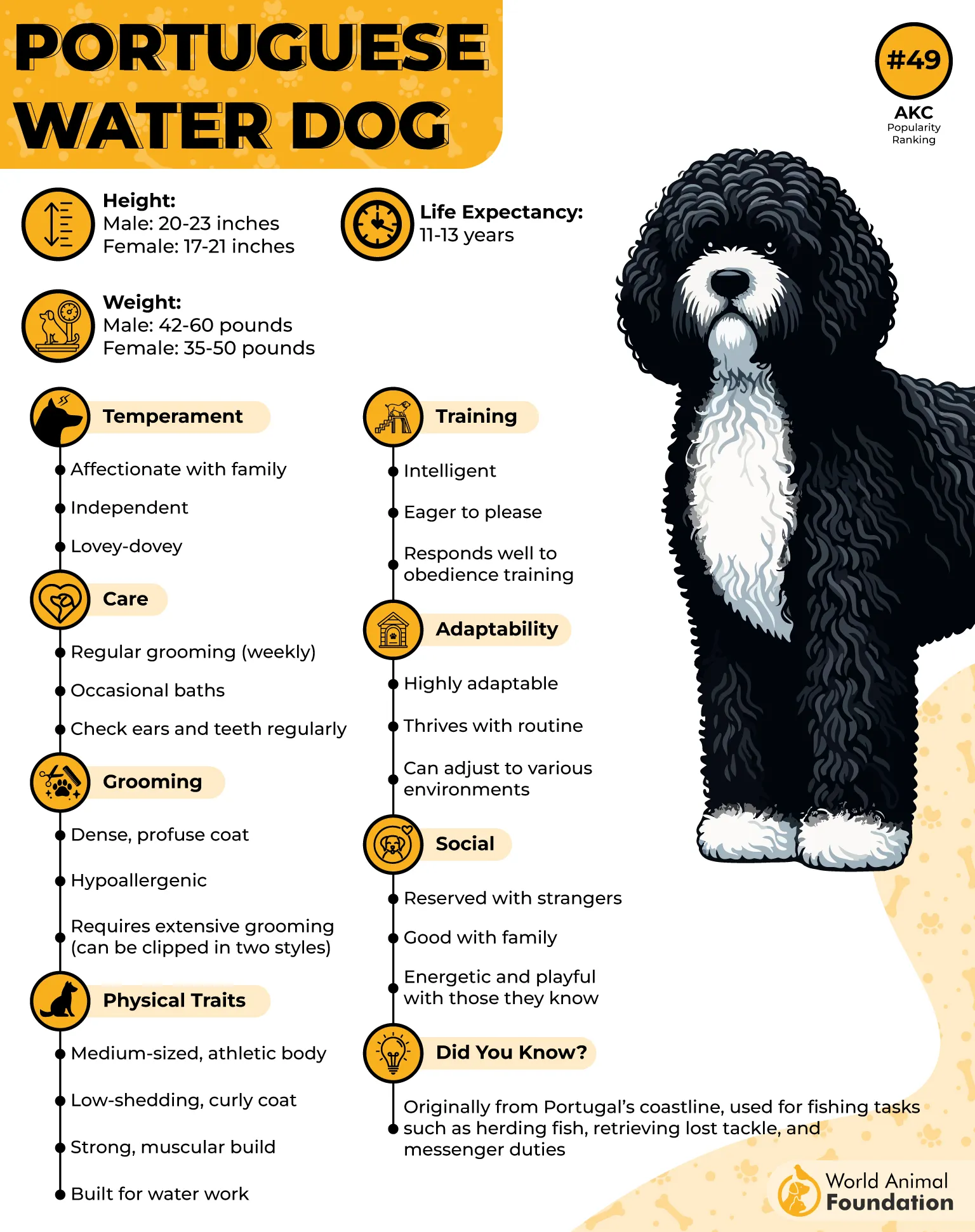
Care Needs
To keep their coats healthy and mat-free, Portuguese Water Dogs require regular grooming, especially if kept in the traditional lion or retriever clip.
Daily exercise of 30–60 minutes is a must to prevent boredom and destructive behaviors. These affectionate pups also need consistent training and attention to thrive as well-adjusted companions.
Fact: The breed gained widespread recognition when Bo and Sunny, two Portuguese Water Dogs, became part of the Obama family in the White House.
7. Bernese Mountain Dog
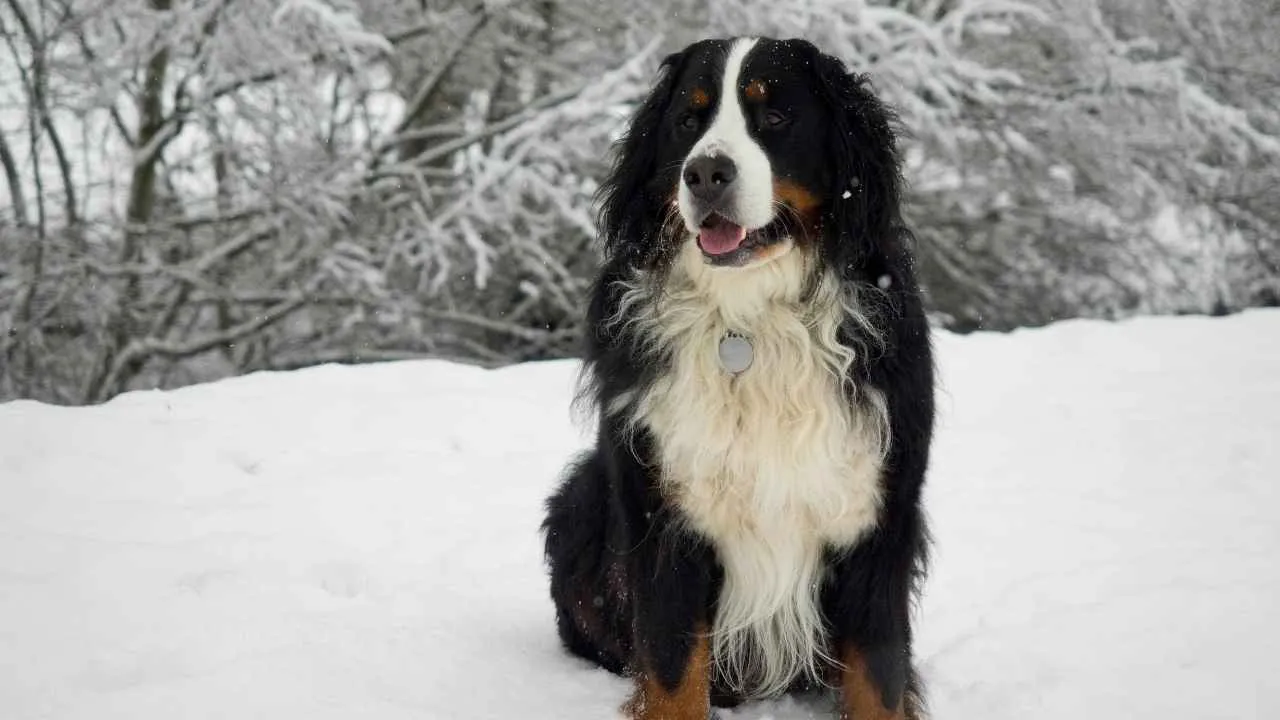
Originally hailing from the chilly landscapes of the Swiss Alps, the Bernese Mountain Dog is a robust and affectionate working breed known for its tolerance of wet and cold climates. These gentle giants are part of the Working Group and are well-equipped for inclement weather, thanks to their dense, tricolored double coat.
Males typically stand 25 to 27.5 inches tall and weigh between 80 to 115 pounds, while females measure 23 to 26 inches and weigh around 70 to 95 pounds. Despite their size and strength, Berners are famously calm, friendly, and affectionate with families, including children and other pets.
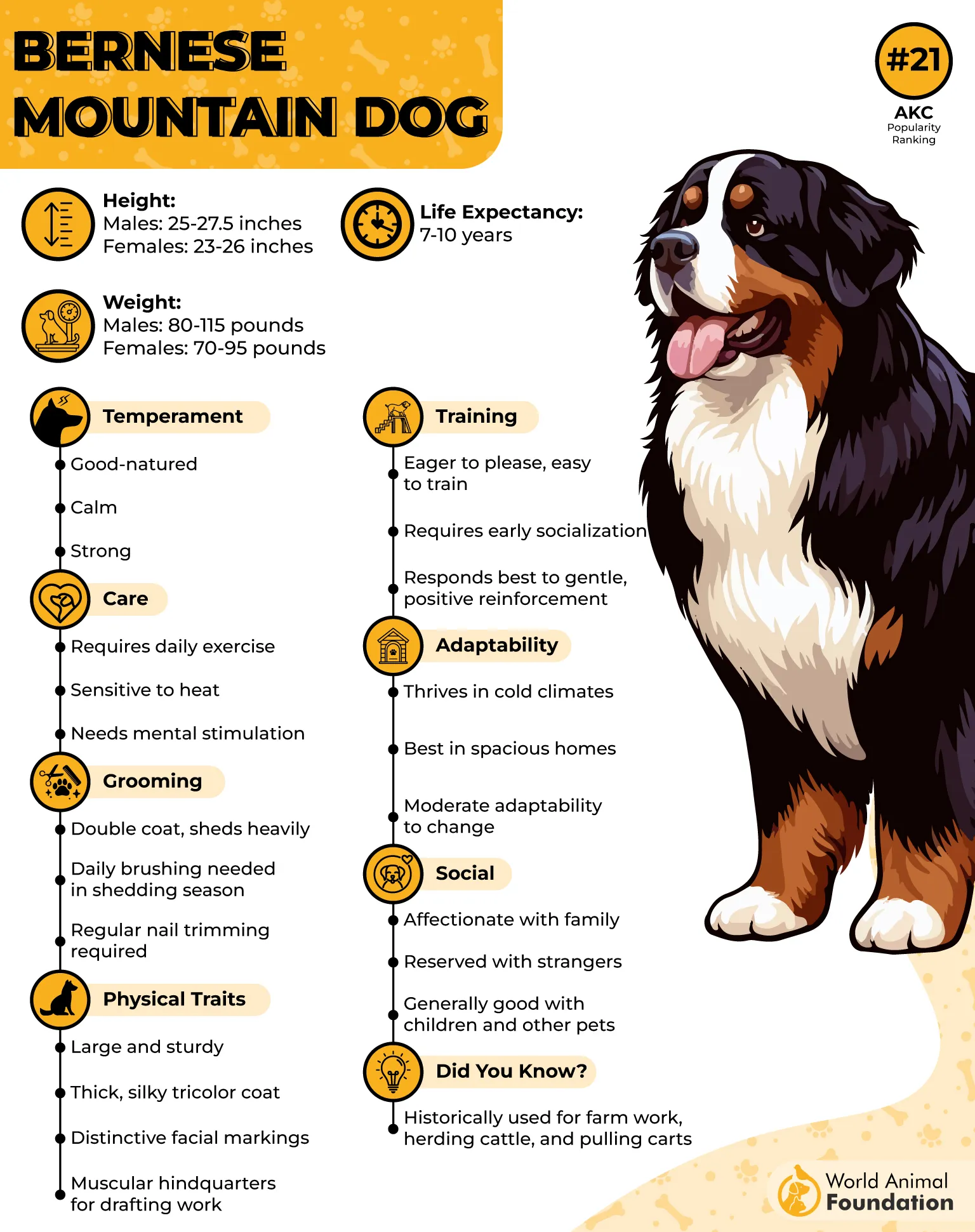
Care Needs
Their thick, silky fur provides natural insulation during wet and cold weather but also requires consistent grooming. Regular brushing—especially during seasonal shedding—helps manage loose hair and maintain coat health.
Although not as exercise-intensive as some other working breeds, Berners benefit from daily activities like walks or light hikes. Their size and steady nature make them ideal companions during rainy-day strolls or relaxed indoor play. Providing ample water and shaded rest areas ensures they remain comfortable in warmer, humid climates.
Fact: Bernese Mountain Dogs, known as Berners, are often referred to as “gentle giants” and have an endearing loyalty to their chosen person.
Conclusion
When it comes to embracing the wet weather, certain dog breeds are not just tolerant—they thrive in it. Whether it’s a Labrador Retriever joyfully bounding through puddles or a Flat-Coated Retriever wagging its tail during rainy walks, these dogs were built for soggy adventures. Their water-resistant coats, energetic nature, and historical roles—like helping to retrieve waterfowl or even hunt waterfowl in cold, icy waters—make them ideal companions during monsoon months. Some breeds, like the medium-sized dog known as the Barbet—a popular French water dog—were even developed specifically for wet terrain.
While many dogs might hate rain and shy away from mud, others practically earn the nickname “mud dog” thanks to their enthusiasm for water. Portuguese Water Dogs, for instance, were bred to retrieve broken nets, showing just how deep their love for the water runs. So if you’re the kind who doesn’t mind a little rain and enjoys outdoor bonding despite the drizzle, choosing one of these rain-loving breeds will make your walks—no matter the weather—a delight. Even breeds originally used to retrieve wild turkey can make perfect wet-weather buddies.


